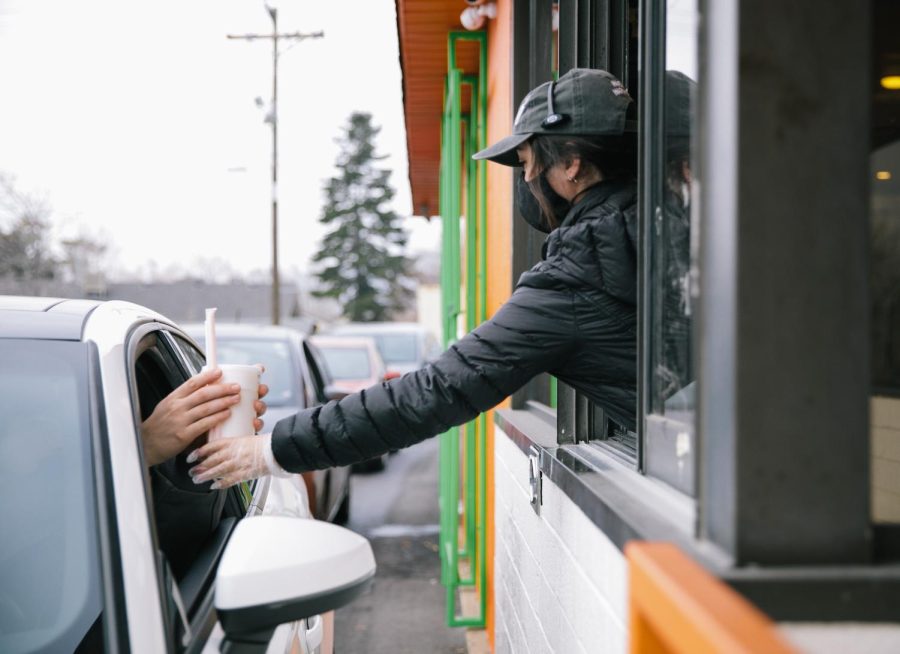Alexander: The Real Reason We Can’t End the Pandemic
Thirst Drinks employee, Ashley VanLeeuwen, working at the Millcreek location in Salt Lake City on Wednesday, Jan. 19, 2022 (Photo by Rachel Rydalch | The Daily Utah Chronicle
January 19, 2022
We are starting our third year in the COVID-19 pandemic. For most of us, it’s our third year of choosing between our safety and financial stability.
The CDC encourages working remotely and social distancing to protect ourselves and decrease the spread. But that isn’t an option for everyone. I work at a restaurant — there is no remote option. Instead, I must choose either to protect myself by staying at home and losing out on income or put the health of myself and my family on the line. And if I have to quarantine, it would result in serious financial setbacks and ruin my future goals.
That’s our reality as service workers and the working class during the pandemic. If you’re under a certain income, you’re out of luck. Our employers and leaders need to understand that capitalistic values and healthcare simply do not mix in the pandemic era. The proof is in our current efforts, which aren’t enough in keeping workers afloat.
Unfortunately, our past attempts to administer economic relief for American households were few, inefficient and short-lived. To aid low-income Americans working in the pandemic, we received only three rounds of stimulus checks. To help renters struggling to pay bills, we received undistributed and mishandled rent relief. And for those struggling with unemployment, some received benefits exceeding their states’ minimum wages, highlighting our national issue with minimum wages.
The present COVID-19 situation isn’t faring any better. Now, more people are getting sick as cases continue to rise. The country is averaging 700,000 cases per day, shattering our previous COVID-19 records. The task of finding a COVID-19 test proves much harder than before, forcing some American workers to forgo a test altogether and return to work. Other Americans have no other choice but to go to work sick, as they are short on income and time off.
Despite this horrifying and dramatic increase in COVID-19 severity, it doesn’t look like any new plans are in place to support low-income and working-class Americans. With nearly 60% of low-income households still experiencing serious financial hardships related to the pandemic, our previous attempts at relief failed to sufficiently support the people who needed it most.
Now, our leaders’ and employers’ primary focus is getting Americans back to work with minimal protection and minimal rewards – in hopes of keeping the economy alive. While I appreciate their initiative and sense of urgency in upholding capitalism, it makes me wonder where this urgency was at the start of the pandemic before we lost 840,000 Americans.
Instead of worrying about financial losses from Americans staying home, we should work to ensure American workers have safe working conditions during this pandemic and after. Introduce sufficient COVID-19 safety measures like mandated social distancing and mask-wearing. Provide workers with more PPE against COVID-19. Allow for paid time off to quarantine and recuperate from COVID-19.
Employers and leaders alike should be working together through policy to protect workers not profits. By prioritizing these measures and the health of our workers, we can build a more resilient workforce that can prepare for and withstand future pandemics and national health crises.
Luckily, the year 2021 saw tremendous changes in the American labor movement. Events like strikes, the labor shortage and unionization across the country helped elevate workers’ safety as a priority moving forward. Fellow Daily Utah Chronicle writers Sarah Buening and Maggie Bringhurst captured exactly how the pandemic evolved the American workforce, highlighting the power we hold as the labor supply. As workers, we can and should demand changes, especially when it comes to our safety. We shouldn’t have to choose between health and financial security.
Instead, we should choose to prioritize our rights as workers. We need to wield our power as workers to enact change and create policy solutions to improve our welfare inside and outside of the workplace. Be it through demonstration or through legislation, service workers and the working class deserve protection against the virus, against unsafe working conditions and against financial instability. By upholding our demands and expectations, we prove to our leaders and employers why they shouldn’t take us for granted.
It may be a new year, but it’s still the same pandemic. This virus is something we have to live with until we can eradicate it, and considering the number of cases, I’m guessing that won’t be for a while. Until then, I’m urging those who put capitalistic values first to try putting workers first. This pandemic made it abundantly clear that capitalism and healthcare do not go hand in hand. Our workers are suffering financially and physically from the pandemic and forcing them to choose between staying safe or paying bills is incredibly unfair.
We can’t just flip a switch to create a better healthcare system, nor can we flip a switch to end the pandemic. But we can eliminate the inequity of financial hardships among American workers and promote safety and financial security amid the pandemic. We can secure a better future and livelihood for service workers and the working class, as well as prepare ourselves for future pandemics and public health scares. To move forward and put an end to this pandemic, we need to implement COVID-19 safety measures and aid that work with American workers, not against them. All it takes is the effort of our leaders, our employers, our community and ourselves.










John Hedberg • Jan 21, 2022 at 9:38 am
I actively anticipated the 2 Pfizer shots I received last Spring, since I was told that these would not only prevent me from getting COVID, but would also prevent me from spreading it. Then, on August 30th, I tested positive for COVID a mere 5 months after my double-dose. I got the booster anyway, but since July, science has shown that vaccinated (even boosted) people not only get CVID, but they transmit COVID at levels roughly the same as people who were never vaccinated. This is the reason CDC Director Rachel Walensky reinstituted her mask recommendation for vaccinated people on July 30th. To quote her press release that day, vaccinated people had “similar viral loads”, and therefore transmit the virus at similar rates to non-vaccinated folks. Oops!
So, the vaccines wear off in about 5 months (hence the need for boosters, which also wear off), and vaccinated folks transmit the virus at roughly the same rate as non-vaccinated folks: that’s the reason the mask recommendation was reinstituted by the CDC for vaccinated people. More recently, there is now evidence that some masks (cloth, for instance) may not be as effective as we initially believed, hence Dr. Fauci’s advice to double or even triple your masks: unless it’s a scientific or medical mask, one mask evidently is not enough to make a great deal of difference. It’s mere theater.
Now we come to Omicron. South Africa, who is weeks ahead of us in the Omicron wave, reports that Omicron is 60% -80% less severe than Delta, and Delta has now been almost entirely replaced by Omicron in the US. When Omicron patients show symptoms at all, they mostly report severity equal to an average head cold. When you consider the science of epidemiology, this circumstance could actually be the opportunity the world has been hoping for without knowing it. In most countries, the vulnerable populations inclined to hospitalization and death (less than 20%) have already been protected by vaccine. Since most pandemics end as the population achieves natural immunity from the virus itself, Omicron is the way nature actually ends most pandemics: a less severe strain infects almost everybody, and thereafter nearly everyone has natural immunity for decades or life.
Let’s turn to the supposedly “unvaccinated” for a moment. Many of them are the same essential worker “heroes” we all saluted during the heat of the first lockdowns. They got COVID, continued to work, and they now have immunity that studies suggest is stronger and more long-lasting than any of the vaccines. Many of the people who now aver from getting the shot are health care workers who know that vaccines can come with unforeseen complications, some even affecting fertility, so there are a large number of young health workers anticipating parenthood who already have natural immunity and don’t see any medical reason to put their posterity at risk by a vaccine that’s still barely tested, long-term. This is just one example of a group more medically knowledgeable than you or I who have perfectly valid reasons for believing that their “personal choice” is a lot more valid than, say, yours!
The CDC website indicates that 63.4 million Americans have had COVID, which means that between 15-20% of Americans already have natural immunity to COVID better than a vaccine. Since the same website also indicates about 80% of Americans have had at least one jab, that means we’re already at the threshold of herd immunity. Since the vulnerable 20% of the population is largely protected by vaccines, maybe the scientific thing to do now with a less severe variant like Omicron is to keep protecting the vulnerable, but allow everyone else who chooses it the option of resuming their normal lives, since getting the virus for most of us is actually the scientific and historical means of ending the pandemic for all of us: full enduring herd natural immunity.
To circle back, Utah’s coronavirus website indicates that for every 2.9 cases of COVID in Utah, 1 of them is among the vaccinated: that’s better than 33% of current cases among those vaccinated and boosted (see Risk Factors: https://coronavirus.utah.gov/case-counts/). Vaccines aren’t slowing down the spread of COVID at all, and neither are most single masks, but at this point, most of us aren’t vulnerable to hospitalization or death. CDC Director Rachel Walensky indicated last week that 75% of COVID deaths were among people who had at least 4 (four!) other serious comorbidities. Most were over 65, and most of these folks are now vaccinated, so is there really a risk of “punching someone else in the face” at this point if I make a personal choice not to wear a mask, or not to get a shot when I already have natural immunity, just because you refuse to face and get a grip on your own apparently groundless and irrational fears?
With Love, All the Best,
J Hedberg